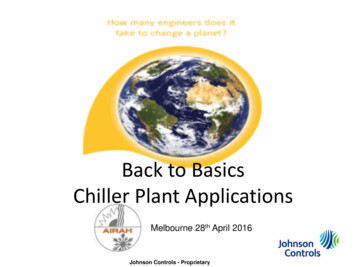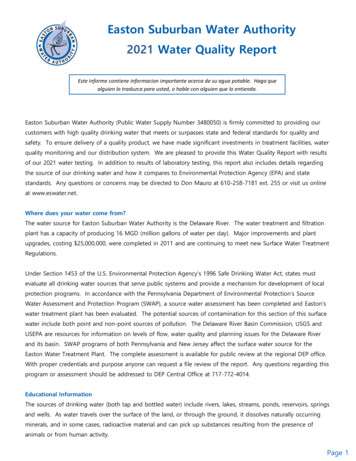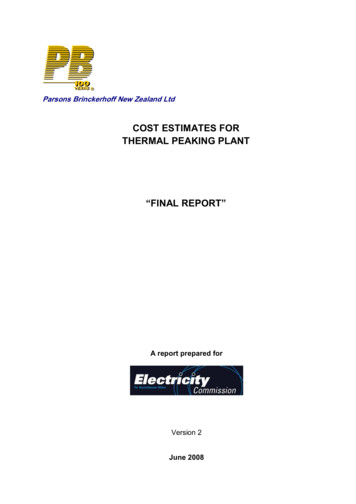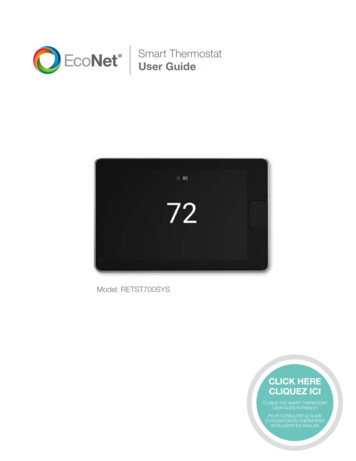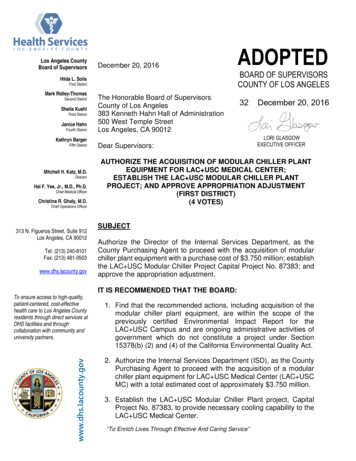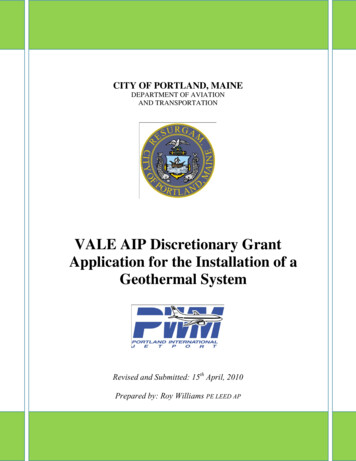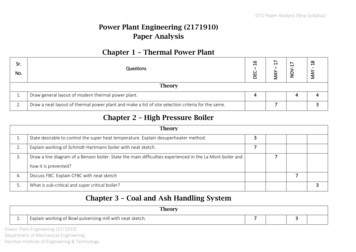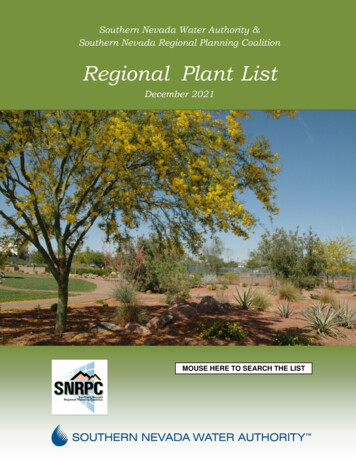
Transcription
1Southern Nevada Regional Planning CoalitionRegional Plant ListSouthern Nevada Water Authority &Southern Nevada Regional Planning CoalitionRegional Plant ListDecember 2021MOUSE HERE TO SEARCH THE LIST1
AcknowledgementsThis Regional Plant List is the product of countless hours of work from members of theSouthern Nevada Regional Planning Coalition’s (SNRPC) Regional Urban Forestry WorkGroup and local arboriculture and horticulture experts. Special thanks to the followingindividuals:2011 ContributorsShane Ammerman, Clark CountyPaul Andricopulos, City of HendersonCleto Arceo, NV EnergyAndrea Baker, Southern Nevada Water AuthorityDave Cornoyer, City of Las VegasAdria DeCorte, Nevada Division of ForestryGreg Deuley, TruGreen LandcarePaula Garrett, University of Nevada Las VegasSteve Glimp, Schilling Horticulture Group, Inc.Bob Hoyes, City of North Las VegasJon Jainga, City of North Las VegasMichael Johnson, City of HendersonJohn Jones, City of North Las VegasTeri Knight, United States Department of AgricultureMatt Koepnick, Nevada Division of ForestryPaul Noe, Star NurseryLisa Ortega, City of HendersonCraig Palmer, University of Nevada Las VegasAlan Paulson, Clark County School DistrictLynn Phelps, professional arboristM.L. Robinson, UNR Cooperative ExtensionNorm Schilling, Schilling Horticulture Group, Inc.Daniel Sinagra, Clark CountyDennis Swartzell, Horticultural Consultants, Inc.Russ Thompson, Clark CountyAmie Wojtech, City of Henderson2021 Update ContributorsShane Ammerman, Clark CountyPaul Andricopulos, City of HendersonAndrea Baker, Southern Nevada Water AuthorityDoug Bennett, Southern Nevada Water AuthorityKeely Brooks, Southern Nevada Water AuthorityBrad Daseler, Clark County Parks & RecreationPaul Dzerk, UNLV Landscape & GroundsCayenne Engle, Nevada Division of ForestrySteve Glimp, City of Las Vegas Superintendent of ParksPreston Goodman, City of HendersonJose Jimenez, UNLV Landscape & GroundsJennifer Margison, Project Manager/DesignerLaura Miller, Landscape ArchitectJohanna Murphy, City of North Las VegasPaul Noe, Star NurseryLisa Ortega, Nevada Division of ForestrySummer Ortiz, Las Vegas Valley Water DistrictM.L. Robinson, UNR Cooperative ExtensionSeth Shanahan, Southern Nevada Water AuthoritySergio Solis-Sauri, Boulder City
iSNWA/SNRPCRegional Plant ListTable of ContentsIntroduction . iiHow to Use the List . iiiProcess for Review and Amendment . iiiTrees . 1Palms and Cycads . 4Shrubs . 5Groundcovers . 7Vines . 8Agaves, Cacti, Succulents, and Yuccas . 8Ornamental Grasses . 10Perennials . 10Plants with Special Needs . 11References . 12i
iiSNWA/SNRPCRegional Plant ListIntroductionThe Southern Nevada Regional Planning Coalition (SNRPC) and the Southern Nevada WaterAuthority (SNWA) are pleased to present this list of plants for the Southern Nevada region.The original 2011 list was created by SNRPC’s Regional Urban Forestry Working Group in conjunctionwith local experts including arborists, horticulturists, and urban foresters. Much of the effort wasbuilt on the foundations of excellent local resources such as the Nevada Division of Forestry’s 2007Cleaner Air, Tree by Tree and the 2005 Centennial edition of Trees for Tomorrow, a project of theHigh Desert Resource Conservation & Development Council. Both projects were made possible bygrants from the Nevada Division of Forestry and the United States Forest Service.The 2021 update was produced by a reconvened working group of local experts. The most notablerevisions are to the Tree section, with an emphasis on deterring use of tree species poorly adaptedto current and future conditions.The intent of this list is to provide a single, region-wide reference for homeowners, landscapedesigners, architects and developers to select appropriate plants when designing their projects inthe Las Vegas area. In addition, it is a tool for those who review those projects—such as cityplanners—to determine if those plants meet applicable codes and ordinances. Lastly, it containsinformation on plant canopy coverage, which is used by the SNWA in the Water Smart Landscapesincentive program.Current and changing conditions in our region make proper plant selection more important thanever. The Las Vegas area is one of the fastest growing urban heat islands, and climate projectionssuggest it will become hotter and drier in the future. Choosing climate resilient plants that cansurvive and thrive in these conditions can help to moderate these effects to sustain and enhancequality of life in our community.For the 2021 update, the Trees, Palms and Cycads sections now include a rating system from 1-5stars, with 1 stars being inappropriate and 5 stars highly-appropriate for our region. A plant's ratingis based on a number of important factors related to climate resilience such as environmentaltolerances, water efficiency, drought tolerance, pathogen resistance and maintenance demands.Additional consideration was given to the potential for the plant to increase or decrease thediversity of our urban forest.For example, Prunus cerasifera 'Atropurea' "Purple Leaf Plum" has a 1-star rating due to it's heatsensitivity, poor drought tolerance, and susceptibility to pests. Acacia aneura "Mulga Acacia," on theother hand, has a 5-star rating because it is a well adapted desert plant with few pests, and it isnot widely planted, so it has potential to diversify the urban forest.This list is not intended to be a list of the only plants allowed in the region, nor is it intended to be anexhaustive, comprehensive list of all desert-appropriate plants. In addition, it is not intended torestrict what plants residents choose to plant in their yards. Rather, we hope that this list will helpresidents and developers make informed decisions about which plants to choose.ii
Regional Plant ListSNWA/SNRPCHow to Use the ListThe list is divided between trees and other plants, including shrubs, groundcovers, vines, succulentsand perennials. It is sorted alphabetically by botanical name and includes the common names ofthe plants. You may use "Ctrl F" to search the document for any term. Several columns ofattributes can be used to determine which plants are appropriate to use in specific situations.Tree ratings depend upon a variety of factors, which are generally noted in the "comments" column.1. Organic mulch – doesn’t perform well without an organic surface treatment, such as wood chips or leaflitter, rather than crushed rock.2. Many cultivars – your nursery may have numerous named cultivars of the same plant species.3. Overplanted - A plant heavily used in the region and at risk for a catastrophic loss of urban tree canopyunder adverse conditions.4. Poor environmental tolerance – Likely to be damaged by cold, heat or other environmental issues.5. Invasive Species – a plant that reproduces aggressively into urban or natural ecosystems, some of whichmay be prohibited by law.6. Mojave native – A plant that grows naturally in some parts of the Mojave Desert.7. Poor Drought Tolerance – unable to persist through prolonged conditions of low soil moisture.8. Susceptible to Pests – Commonly attacked by diseases or insects.9. Short lifespan – not expected to achieve the expected lifespan under local conditions.10.Protected microclimate required – Capable of thriving, but only if protected from the harshest summerconditions, such as east and north-facing exposures.Process for Review and AmendmentThe SNWA/SNRPC Plant List is intended to be a living document and will therefore be open toperiodic review and amendment. Requests to add plants or modify information must besubmitted to the SNWA Conservation Division by emailing conservation@snwa.com. Requestsshould include the following information at a minimum:1.2.3.4.the applicant’s name and contact informationthe botanical and common name(s) of the plant(s) to be considered.for the revision to be considered, and supporting documentation.For new plants, documentation shall include the plants’ proposed attributes and informationregarding the plant's history and performance in similar climates.5. Supporting documentation must be verified by a certified arborist or horticulturist.iii
Bauhinia purpureaBouhinia x blakeanaBrachychiton acerifoliusBrachychiton populneusCallistemon viminalisCalocedrus decurrensCasuarina cunninghamianaCasuarina equisetifoliaCedrus atlanticaCedrus deodoraCeltis australisCeltis occidentalisCeltis laevigata var. reticulataCeltis sinensisCeratonia siliquaCercis canadensisCercis canadensis var. mexicanaCercis canadensis var. texensisCercis chinensisCercis occidentalisChilopsis linearisChionanthus retususx Chitalpa tashkentensisCinnamomum camphoraCitrus spp.Condalia hookeriCordia boissieriCorymbia papuana ( Eucalyptus )Cotinus coggygriaCupaniopsis anacardioidesCupressus arizonica var. glabraCupressus sempervirensCupressus leylandiiDalbergia sissooEbenopsis ebano ( Pithecellobium)Elaeagnus angustifoliaElaeocarpus sylvestris ( decipiens )Eriobotrya deflexaEriobotrya japonicaEucalyptus camaldulensisEucalyptus gunniiEucalyptus microthecaEucalyptus nicholiiEucalyptus polyanthemosEucalyptus rudisEucalyptus sideroxylonEucalyptus spathulataEysenhardtia MMLL200 N N 00500200200NNNNNYNNYYYYCommentsMMSMFFM,FSYes or No Tolerates Compacted SoilYes or No Compatible with Turf GrassYes or No Compatible with Overhead UtilitiesEEEEEEED---- N M Y Y Y 120Not RecommendedL NLY Y Y 120---- N ---- Y Y Y 120---- N ---- Y Y Y 120S N M Y Y Y 120L N ---- Y Y Y 200L N ---- Y Y Y 120L,S NLY Y Y 200L N ---- N N N 80Not RecommendedNot RecommendedNot RecommendedNot RecommendedNot RecommendedS NLN N N 80S NLN N N 120---- N ---- N N N 80---- N ---- N N N 80(cu. feet) Minimum Soil VolumeV(sq. feet) Minimum Soil Surface AreaSExcessive LitterEL, F, 885133Yes or No Spines or ThornsBiogenic Volatile Organic CompoundsL, M, H(BVOC's)Yes or No Parking Lot TreeYes or No Street TreeYes or No Buffer TreeGrowth Rate5 2 4 4 4 5 4 3 3 3 2 1 2 1 1 3 3 5 4 Tree Type'Marina'Mulga AcaciaCootamundra WattleDesert Oak, Wiry WattleIronwoodCoonavitra WattleWeeping AcaciaWillow AcaciaBlue Leaf WattleShoestring AcaciaAmur MapleBox ElderDwarf Japanese MapleAfrican Fern PineTree of HeavenMimosa, Silk TreeStrawberry TreeMarina Strawberry TreeAnacacho Orchid TreeChihuahuan Orchid TreePurple Orchid Tree, ButterflyTreeHong Kong Orchid TreeIllawarra Flame TreeBottle TreeWeeping BottlebrushIncense CedarRiver She OakAustralian PineBlue Atlas CedarDeodar CedarMediterranean HackberryCommon HackberryNetleaf/Western HackberryChinese HackberryCarobEastern RedbudMexican RedbudTexas/Oklahoma RedbudAvondale Chinese RedbudWestern RedbudDesert WillowChinese Fringe TreeChitalpaCamphor TreeCitrus TreeBrazilian BluewoodTexas OliveGhost GumSmoke TreeCarrotwoodArizona CypressItalian CypressLeyland CypressIndian RosewoodTexas EbonyRussian OliveJapanese BlueberryBronze LoquatLoquatRed River GumCider GumCoolibahWillow Leaf Peppermint GumSilver Dollar GumDesert/Flooded GumRed IronbarkNarrow-leaf GimletKidneywoodD, E, S'Purpurea'Common NameS, M, FTREESAcacia aneuraAcacia baileyanaAcacia coriaceaAcacia estrophiolataAcacia jenneraeAcacia pendulaAcacia salicinaAcacia cupularis ( saligna )Acacia stenophyllaAcer tataricum ssp. ginnalaAcer negundoAcer palmatum var. atropurpureumAfrocarpus falcatusAilanthus altissimaAlbizia lebbekoides ( julibrissin )Arbutus unedoArbutus x andrachnoidesBauhinia lunarioidesBauhinia macrantheraCultivar(sq. feet) CoverageBotanical NameComments:1. Organic mulchrecommended2. Many cultivars3. Overplanted4. Poor environmentaltolerances5. Invasive species6. Mojave native7. Poor drought tolerance8. Susceptible to Pests9. Short lifespan10. Protected microclimatenecessaryRatingRating: Based on a combination of factors related to climateresiliency such as environmental tolerances (heat, cold),water efficiency, drought tolerance, pathogen resistance,along with some additional factors like diversity, maintenanceneeds, and invasiveness. Plants rated from 1 (leastappropriate) to 5 (most appropriate)Tree Size (based on both height and width): Small ( 20 ft),Medium (20-29 ft), Large (30- 45ft), EXtra Large ( 45ft)Tree Type: Deciduous, Evergreen, Semi-evergreenGrowth Rate: Slow, Moderate, FastWater Needs: Very Low, Low, Moderate, HighExcessive Litter: Leaves, Flowers, Seeds/FruitBiogenic Volatile Organic Compounds: Low, Medium, High,or data not available ----V,L, M, H Water NeedsRegional Plant ListKEYS, M, L, X Tree SizeHeight (average)(feet)Width (average)(feet)SNWA/SNRPC4,9,1053, 101,4,7,10112 M 25 25 368Not Recommended1,4,9,102 2 2 3 2 4 4 3 2 4 4 5 2 4 2 4 4 2 3 4 3 1 1 3 4 5 3 3 1 3 2 1 4 4 1 2 1 1 4 3 4 3 3 4 4 4 4 Not RecommendedNot RecommendedNot RecommendedN H N N N 80Not RecommendedN ---- N N Y 200N ---- N N Y 200NLN N Y 200Not RecommendedN ---- N Y N 200N ---- N Y N 200NLN Y N 120Not RecommendedN M N Y Y 200Not RecommendedNLN N N 120NLN N N 120Not RecommendedNLN N N 80N M N Y N 120N ---- N N N 80Not RecommendedNot RecommendedNN N N 80Y ---- N N N 80N ---- N N Y 120N H N Y Y 240N M N N N 80Not RecommendedNLN N Y 200Not RecommendedNot RecommendedN ---- Y Y Y 200Y ---- N Y Y 120Not RecommendedNot RecommendedNot RecommendedNot RecommendedN H N N Y 240N HY Y Y 200N HY Y Y 200N H N N Y 200N H N N Y 200N H N Y Y 240N H N N Y 200N ---- N N Y 120N ---- N Y Y 6E MM----E FE FE MMMMLL----D M MD F MD S L,ME M L,MD SD SMMLLSS-------D S,M L,M ---D M M L,F,SD S M ---EDSEDM M,H SM V ---S,M M ---M LSS L,M ----E M L,M ---E M LS S,M VEEEEEEEES-------M M ---M MLM L,M LF M ---F L,M LM M ---M M ---M L ---M L ----200 N Y Y400 N N N400 N N N300 N Y N1300 N Y N1000 N N N300 N N Y400 N Y N500 N Y Y300 N Y Y200 N Y Y300 Y N N200 N Y Y2002002001300100NNNNNNNYNYYYYNY600 N Y N1300 Y N N300 Y N 9485,7,81,4,7,101,4,7,8,9,101,4,7,8,9,105551,511
SNWA/SNRPCTREES (continued)Fraxinus angustifoliaFraxinus angustifolia ssp.oxycarpa'Raywood'Fraxinus anomalaFraxinus uhdeiFraxinus velutinaFraxinus velutina'Bonita'Fraxinus velutina'Modesto'Fraxinus x velutina'Fan-West', 'Fan-Tex'Geijera parvifloraGeoffroea decorticansGinkgo bilobaGleditsia triacanthos var. inermisGrevillea robustaHavardia mexicanaHavardia pallens ( Pithecellobium)Ilex x altaclerensis'Wilsonii'Ilex cornuta'Burfordii'Ilex x 'Nellie R. Stevens''Nellie R. Stevens'Ilex vomitoriaJacaranda mimosifoliaJuniperus monospermaJuniperus osteospermaJuniperus scopulorumKoelreuteria bipinnataKoelreuteria paniculataLagerstroemia indicaLaurus nobilisLeucaena leucocephalaLeucaena retusaLigustrum lucidumLysiloma watsoniiMaclura pomifera'White Shield'Magnolia grandiflora'Little Gem'Melia azedarachMorus alba (Female)'Unryu'Olea europaea'Swan Hill', 'Wilsonii'Olneya tesotaParkinsonia aculeataParkinsonia floridaParkinsonia microphyllaParkinsonia praecoxParkinsonia x 'AZT Thornless''AZT Thornless'Parkinsonia x ' Desert Museum''Desert Museum'Parkinsonia x 'Sonoran Emerald''Sonoran Emerald'Parkinsonia x sonoraePaulownia kawakamii ( tomentosa )Pinus brutiaPinus brutia var. eldaricaPinus canariensisPinus halepensisPinus pineaPinus roxburghiiPinus sabinianaPinus thunbergiiPistacia atlanticaPistacia chinensisPistacia lentiscusPistacia x 'Red Push''Red Push'Pittosporum phillyraeoidesPlatanus acerifoliaPlatanus mexicanaPlatanus racemosaPlatanus wrightiiPlatycladus orientalisPodocarpus macrophyllusPopulus nigra var. italicaPopulus albaPopulus fremontiiNarrow-leaved AshRaywood AshSingle-leaf AshShamel AshVelvet/Arizona AshBonita/Montebello AshModesto AshFan-West/Fan-Tex AshAustralian WillowChilean Palo VerdeMaidenhair TreeThornless Honey LocustSilk OakMexican EbonyTenazaWilson HollyBurford HollyNellie R. Stevens HollyYaupon HollyJacarandaOne-seed JuniperUtah JuniperRocky Mountain JuniperChinese Flame TreeGoldenrain TreeCrape MyrtleBay LaurelWhite Lead TreeGolden Leadball TreeGlossy PrivetFern of the DesertOsage OrangeSouthern Little Gem MagnoliaChinaberryFruiting/Contorted MulberryFruitless OliveDesert IronwoodMexican Palo VerdeBlue Palo VerdeFoothill Palo VerdePalo BreaThornless Hybrid Palo VerdeDesert Museum Palo VerdeSonoran Emerald Palo VerdeSonoran Palo VerdeSapphire Dragon TreeTurkish/Calabrian PineAfghan/Mondell PineCanary Island PineAleppo PineStone PineChir PineFoothill/Gray PineJapanese Black PineMt. Atlas Mastic TreeChinese PistacheMastic TreeRed Push PistacheWillow PittosporumLondon Plane Tree, SycamoreMexican SycamoreCalifornia SycamoreArizona SycamoreOriental ArborvitaeYew PineLombardy PoplarWhite PoplarFremont Cottonwood22 1 4 1 2 2 2 2 2 4 3 4 2 5 4 2 2 2 2 1 4 4 4 2 3 2 4 1 5 1 3 3 1 2 3 3 4 1 4 5 5 5 3 4 5 1 3 2 2 2 3 3 4 1 3 4 4 4 5 2 3 2 3 2 3 1 3 2 302365301339427229429425959133942530M----D SD SD MVMMS---SD MD MLL-------E SE SE MLLM----------D MM----E MM----D M L,M ---S MD MLMS----D M M L,F,SE S,M M ---D S V --EFMLE S,M ME M ME M MLLL,SSDEDEMMSMMMMLMLSL,SLL,SL,FDFMLDF M,HLE S,M L,M ---DFMLNot RecommendedNot RecommendedN ---- N N N 120Not RecommendedNot RecommendedNot RecommendedNot RecommendedNot RecommendedNot RecommendedY ---- Y Y Y 120N M N N N 200N M N Y N 200Not RecommendedY ---- Y Y N 200N ---- N N N 120Not RecommendedNot RecommendedNot RecommendedNot RecommendedNot RecommendedN ---- N N Y 80N ---- N N Y 120N ---- N N Y 200Not RecommendedN H N Y N 200Not RecommendedNLN N Y 80Not RecommendedN M N Y Y 120Not RecommendedN ---- N N N 80Y ---- N Y N 200Not RecommendedNot RecommendedN ---- N N N 120NLY Y Y 120Y M Y Y Y 120Not RecommendedY M Y Y Y 200Y M N Y Y 120Y ---- N N Y 200N M Y Y Y 120N M Y Y Y 120N M Y Y Y 120Y M N Y Y 120Not RecommendedN ---- N N Y 240Not RecommendedNot RecommendedNot RecommendedN M N Y Y 240N M N Y Y 200NLN Y Y 240Not RecommendedN ---- N N N 200N M Y Y N 200N ---- N Y Y 120N M Y Y N 200N ---- Y Y Y 120Not RecommendedN H N Y N 200Not RecommendedN ---- N N N 240Not RecommendedNLN N Y 120Not RecommendedN ---- N N N 240Not Recommended500 N Y Y500 N N N600 N Y N1000 N Y N600 N N N100 N N Y200 N N Y300 N N Y300 N N N1000 N Y N200 N Y Y300 N N Y200 N N Y1000 N Y N350 N Y N350 N Y N500 Y N N10003001000500500500300YNYYYYNNNNNNNNNYNNNNY1000 N Y N1600 N Y N700 N Y N1300 N Y N100010003501000200NYNYNNYNYNNNYNY1300 N Y N1600 N Y N200 N Y N1600 N Y NCommentsYes or No Tolerates Compacted SoilYes or No Compatible with Turf GrassYes or No Compatible with Overhead Utilities(cu. feet) Minimum Soil Volume(sq. feet) Minimum Soil Surface AreaExcessive LitterL, F, SD MYes or No Spines or ThornsBiogenic Volatile Organic CompoundsL, M, H(BVOC's)Yes or No Parking Lot TreeYes or No Street TreeYes or No Buffer TreeGrowth RateV,L, M, H Water NeedsTree TypeD, E, SCommon NameS, M, FCultivar(sq. feet) CoverageBotanical NameComments:1. Organic mulchrecommended2. Many cultivars3. Overplanted4. Poor environmentaltolerances5. Invasive species6. Mojave native7. Poor drought tolerance8. Susceptible to Pests9. Short lifespan10. Protected microclimatenecessaryRatingRating: Based on a combination of factors related to climateresiliency such as environmental tolerances (heat, cold),water efficiency, drought tolerance, pathogen resistance,along with some additional factors like diversity, maintenanceneeds, and invasiveness. Plants rated from 1 (leastappropriate) to 5 (most appropriate)Tree Size (based on both height and width): Small ( 20 ft),Medium (20-29 ft), Large (30- 45ft), EXtra Large ( 45ft)Tree Type: Deciduous, Evergreen, Semi-evergreenGrowth Rate: Slow, Moderate, FastWater Needs: Very Low, Low, Moderate, HighExcessive Litter: Leaves, Flowers, Seeds/FruitBiogenic Volatile Organic Compounds: Low, Medium, High,or data not available ----S, M, L, X Tree Size(feet)Height (average)(feet)Width (average)Regional Plant 1,2,7,81,6,7,8
SNWA/SNRPCTREES (continued)Prosopis albaProsopis x albaProsopis chilensisProsopis x chilensisProsopis x ' Seedless AZT'Prosopis glandulosaProsopis glandulosaProsopis glandulosa var. torreyanaProsopis pubescensProsopis velutinaPrunus carolinianaPrunus cerasiferaPrunus mexicanaPunica granatumPyrus calleryanaQuercus agrifoliaQuercus buckleyiQuercus canbyiQuercus douglasiiQuercus fusiformisQuercus gambeliiQuercus ilexQuercus lobataQuercus macrocarpaQuercus muehlenbergiiQuercus polymorphaQuercus shumardiiQuercus suberQuercus texanaQuercus turbinellaQuercus x undulataQuercus virginianaQuercus virginianaQuercus virginianaQuercus virginianaQuercus wislizeniRhamnus alaternusRhus lanceolataRobinia pseudoacaciaRobinia x ambiguaSalix babylonica ( matsudana )Salix babylonica ( matsudana )Salix gooddingiiSalix x salamonii ( x sepulcralis )Sambucus cerulea ( nigra ssp.cerulea)Sapindus saponaria var. drummondiiSchinus molleSchinus terebinthifoliusSearsia lancea ( Rhus)'Phoenix', 'AZT''AZT', 'Arizona''AZT''Maverick', 'AZT''Atropurea''Cathedral''Heritage''High Rise''Tortuosa', 'Snake'Senegalia greggii ( Acacia)Sophora secundifloraSophora secundifloraStyphnolobium japonicumThuja occidentalisThuja plicataTipuana tipuTriadica sebiferaUlmus americanaUlmus crassifoliaUlmus glabraUlmus parvifoliaUlmus pumilaUngnadia speciosaVachellia constricta ( Acacia)Vachellia farnesiana ( Acacia)'Silver 8368236368852365305307221333687223 4 3 4 4 4 4 5 5 5 1 1 3 3 2 2 3 4 4 4 4 3 3 4 4 4 3 4 3 5 5 4 4 4 4 2 3 4 2 2 2 2 3 1 Blue Elderberry5 M 15 25 368 S MWestern SoapberryCalifornia Pepper TreeBrazilian Pepper TreeAfrican SumacCatclaw Acacia, Gregg'sCatclawTexas Mountain Laurel3 2 2 3 2530252025302520ML,F NNNNNNNNNNNNNNNNNYYN600 N Y N200 N N YNYYYYYNNNNNNNNNNNNNYYNNNN200 N Y Y300 N N Y600 N Y N----YLN N N 80300 Y N Y5 S 15 12 85 E S L,MSN----N Y Y 80200 N N YSilver Mountain Laurel5 S 15 12 85 E S L,MSN----N Y Y 80200 N N YJapanese Pagoda TreeArborvitaeWestern Red CedarTipu TreeChinese Tallow TreeAmerican ElmCedar ElmCamperdown ElmLacebark ElmSiberian ElmMexican BuckeyeWhitethorn AcaciaSweet Acacia3 2 2 1 1 3 4 3 2 1 4 5 4 LN M N Y N 200Not RecommendedNot RecommendedNot RecommendedNot RecommendedD M ML NLN N N 240D M M ---- N ---- N Y N 200D S M ---- N ---- N N N 80Not RecommendedNot RecommendedD S L,M S N ---- N N N 80D M V ---- Y M N N N 80S M LS Y M N Y N 1201000 N N 1520530858572213394272213394294285133236D 7,8,91,61,4,7,8,9N N Y 120 500 N Y N368 D M M ---- N ---- N Y N 120 500 N Y NNot Recommended530Not Recommended368236 E M,F L,M L,S NLN N Y 120 300 N Y N5 S 15 20 236 D S,M VLSMLMXLSLXSSMCommentsYes or No Tolerates Compacted SoilYes or No Compatible with Turf GrassYes or No Compatible with Overhead Utilities(cu. feet) Minimum Soil Volume(sq. feet) Minimum Soil Surface AreaExcessive LitterL, F, SYes or No Spines or ThornsBiogenic Volatile Organic CompoundsL, M, H(BVOC's)Yes or No Parking Lot TreeYes or No Street TreeYes or No Buffer TreeGrowth RateS F L,M S Y ---- N Y Y 200S F LS N ---- Y Y Y 200S F L,M S Y ---- N Y Y 200S F L,M S N ---- Y Y Y 200S F L ---- Y ---- N Y Y 200D F LS Y M N Y N 200D F LS N M Y Y N 200D M VL Y M N Y N 120D M VS Y M N Y N 120S F VS YLN Y Y 200Not RecommendedNot RecommendedD M MS N ---- N N N 120D M MS Y ---- N N N 120Not RecommendedNot RecommendedD S,M L,M L N H N Y Y 200D M M ---- N ---- N Y N 200D S M ---- N M N Y N 200E M,F L,M S N H N Y Y 200D M MS N M N N N 120E M MS N H N Y Y 200D M M L,S N M N N N 200D S M L,S N ---- N Y N 240D S,M M L,S N ---- N Y Y 200E M L,M ---- N ---- N Y Y 200D M M L,S N ---- N Y N 200S N H N Y Y 200S S,M MD M M L,S N ---- N N N 200E M L ---- N ---- N N Y 80S M L ---- N ---- N N Y 80S N H N Y Y 200S S,M MS S,M MS N H N Y Y 200S N H N Y Y 200E S,M MS S,M MS N H N Y Y 200Not RecommendedE S M ---- N ---- N N N 80D M L,M ---- NLN N N 80Not RecommendedNot RecommendedNot RecommendedNot RecommendedD F H L,F,S N ---- N N N 200Not RecommendedArgentine MesquiteThornless Hybrid MesquiteChilean MesquiteThornless Chilean MesquiteSeedless Hybrid MesquiteTexas Honey MesquiteThornless Honey MesquiteWestern Honey MesquiteScrewbean MesquiteVelvet MesquiteCarolina Cherry LaurelPurple Leaf PlumMexican PlumPomegranateOrnamental PearCoast Live OakBuckley/Texas Red OakCanby/Sierra Red OakBlue OakEscarpment OakGambel OakHolly OakValley OakBur OakChinquapin/Chinkapin OakMonterrey OakShumard OakCork OakNuttall OakDesert Scrub OakWavy Leaf OakSouthern Live OakCathedral Live OakHeritage Live OakHigh Rise Live OakInteror Live OakItalian BuckthornPrairie Flameleaf SumacBlack LocustIdaho LocustChinese WillowCorkscrew WillowGoodding WillowWeeping WillowMLMMV,L, M, H Water NeedsTree TypeD, E, SCommon NameS, M, FCultivar(sq. feet) CoverageBotanical NameComments:1. Organic mulchrecommended2. Many cultivars3. Overplanted4. Poor environmentaltolerances5. Invasive species6. Mojave native7. Poor drought tolerance8. Susceptible to Pests9. Short lifespan10. Protected microclimatenecessaryRatingRating: Based on a combination of factors related to climateresiliency such as environmental tolerances (heat, cold),water efficiency, drought tolerance, pathogen resistance,along with some additional factors like diversity, maintenanceneeds, and invasiveness. Plants rated from 1 (leastappropriate) to 5 (most appropriate)Tree Size (based on both height and width): Small ( 20 ft),Medium (20-29 ft), Large (30- 45ft), EXtra Large ( 45ft)Tree Type: Deciduous, Evergreen, Semi-evergreenGrowth Rate: Slow, Moderate, FastWater Needs: Very Low, Low, Moderate, HighExcessive Litter: Leaves, Flowers, Seeds/FruitBiogenic Volatile Organic Compounds: Low, Medium, High,or data not available ----S, M, L, X Tree Size(feet)Height (average)(feet)Width (average)Regional Plant ListKEY1800 N Y N1300 N Y N200 N Y Y200 N N Y200 N N Y400 Y N ,2,3,4,71,5,8,7
2525122368536836885VVLMXylosma3 S 15 12 85 E S,M MSawleaf ZelkovaJujube2 L 40 30 5304 M 25 20 236 D S300200500500---- NMN N Y 80MSNot RecommendedYH N N N 80NNNYNNNYYYYY1,4300 N Y -------------------?Eve's Necklace? M 25 15 133 S?N----? ? N 120 350 N ? N1 4 4 2 3 2 3 3 3 3 5 3 3 2 1 3 3 3 3 3 4 3 4 1 3 3 3 Bismarck PalmMexican Blue PalmMexican Dwarf Blue PalmPindo PalmMediterranean Fan PalmJapanese Sago PalmChinese Fan PalmRibbon Fan PalmCarnarvon Fan PalmTaraw Fan PalmMazari PalmCanary Island Date PalmDate PalmSenegal Date PalmPygmy Date PalmCliff DateWild DateGreek/Cretan Date PalmPuerto Rican Hat PalmHispaniolan PalmettoMexican Sabal PalmPalmettoR
NWA/SNRPC Regional Plant List. Regional Plant List. Introduction . The Southern Nevada Regional Planning Coalition (SNRPC) and the Southern Nevada Water Authority (SNWA) are pleased to present this list of plants for the Southern Nevada region. The original 2011 list was created by SNRPC's Regional Urban Forestry Working Group in conjunction



